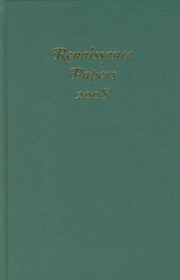Book contents
- Frontmatter
- Contents
- Renaissance Papers
- Cardinal Wolsey: The English Cardinal Italianate
- Pope Gregory and the Gens Anglorum: Thomas Stapleton's Translation of Bede
- The Spenserian Paradox of Intended Response
- Lucan, Marlowe, and the Poetics of Violence
- Hell Is Discovered
- Private and Public Plays in the Private Theaters: Speculation on the Mercenary Methods of Second Paul's and Second Blackfriars
- Staging Dismemberment in Early Modern Drama: Playing Mnemonics and Meaning
- Serving Theater in Volpone
- Troilus and Cressida: An Epitaph for the History Play
- “What thing thou art, thus double-formed”: Naming, Knowledge, and Materialism in Paradise Lost
Hell Is Discovered
Published online by Cambridge University Press: 12 September 2012
- Frontmatter
- Contents
- Renaissance Papers
- Cardinal Wolsey: The English Cardinal Italianate
- Pope Gregory and the Gens Anglorum: Thomas Stapleton's Translation of Bede
- The Spenserian Paradox of Intended Response
- Lucan, Marlowe, and the Poetics of Violence
- Hell Is Discovered
- Private and Public Plays in the Private Theaters: Speculation on the Mercenary Methods of Second Paul's and Second Blackfriars
- Staging Dismemberment in Early Modern Drama: Playing Mnemonics and Meaning
- Serving Theater in Volpone
- Troilus and Cressida: An Epitaph for the History Play
- “What thing thou art, thus double-formed”: Naming, Knowledge, and Materialism in Paradise Lost
Summary
MANY playhouses during the English Renaissance employed a trapdoor on their stage. Several types of evidence point to this fact, primarily drawings and stage directions, both proper and embedded. Much of the evidence is vague, such as the stage direction, “Hell is discovered,” in the second quarto of Marlowe's Doctor Faustus. Other evidence, however, is clear and explicit, such as the call for two actors to be “ready to open the trapdoor” in the manuscript of Massinger's Believe As Ye List.
It is not easy to identify which theatres had trapdoors and which did not; none of the extant playhouse drawings clearly identify the theatre to which they belong, save only the DeWitt drawing of the Swan. It is even more difficult to ascertain specific details about a particular theatre's trapdoor, including its size, location on the platform, and opening mechanism—in other words, how each individual trapdoor differed from the rest. For despite Robert Cohen's assertion that each theatre was equipped with “a 4-by-4-foot trap door,” each was different.
More important than the physical structure of the trapdoors is the effect they had on Renaissance plays. Many playwrights, including William Shakespeare, wrote their plays for specific companies; those companies generally operated out of a primary space. While writing for the Lord Chamberlain's Men and later the King's Men, Shakespeare wrote many of his earlier plays for production at the Globe and later for the Blackfriars. The benefits and limitations of each trapdoor dictated how playwrights would utilize them.
- Type
- Chapter
- Information
- Renaissance Papers 2008 , pp. 65 - 88Publisher: Boydell & BrewerPrint publication year: 2009



